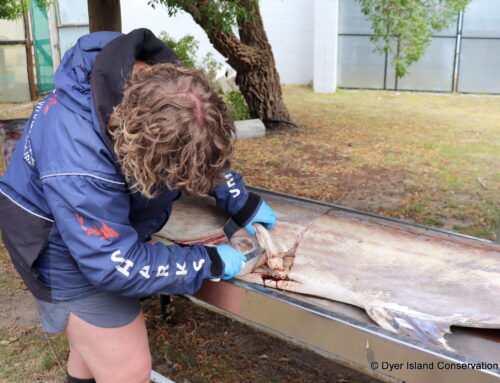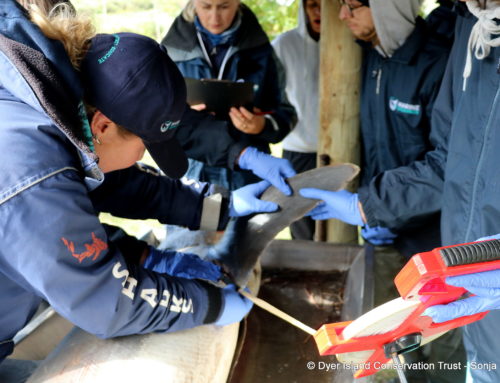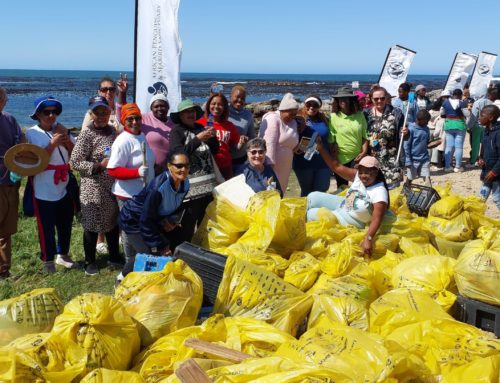DOLPHINS
September 05, 2010 by dyertrust
DOLPHINS
Which species of dolphins do we find around Dyer Island ?
There are 2 different species of dolphins which are regular visitors in our waters; the Humpback dolphin and the Indo-Pacific bottlenose dolphin.
We have a resident pod of humpback dolphins (Sousa chinensis) around Dyer Island. These dolphins can be easily confused with the bottlenose dolphin. Humpback dolphins have a long, slender beak, and their body is lighter in colour than that of the bottlenose dolphin. Humpback dolphins have a small dorsal fin and a round hump before this dorsal fin, hence their name. The belly tends to be white and the calves and juveniles are paler than the adults (very light grey). Like all cetaceans with teeth, they have just one blowhole (nostril). These dolphins often surface at a 45 angle when coming up to breathe. These dolphins measure between 2 and 2.5 meters long with an average weight of 150 kg. They are usually found along the coast where they inhabit the shallows or inshore waters. They are rarely found in waters deeper than 20 meters, placing them in frequent contact with human activities.
The Common bottlenose dolphin (Tursiops truncatus) is the archetypal dolphin. They are most commonly seen dolphin on television and in aquariums. Around Dyer Island, we can encounter the Indo-Pacific bottlenose dolphin which is a sub-species of the bottlenose dolphin. The best way to describe the Indo-Pacific bottlenose dolphin is to compare it with the Common bottlenose dolphin. Indo-Pacific bottlenose dolphins have a longer and more slender beak than the Common bottlenose dolphin and their whole body is smaller and slimmer. Their body colour is also lighter than that of the Common bottlenose dolphin. Their belly tends to be white and dark spots appear when the animal reaches sexual maturity. The dorsal fin is large and curved. They usually measure between 2.4 and 2.5 meters long and weigh between 180 and 230 kg. They are usually found in coastal waters and are rarely found in waters deeper than 30 meters. Bottlenose dolphins are therefore commonly in contact with human activities. This makes them particularly vulnerable to the alteration or loss of their habitat.
What do the dolphins eat around Dyer Island ?
The Humpback dolphins mainly eat fish that can be found in shallow waters such as sardines, mackerels and mullets but they can also eat cuttlefish and small squids.
The Indo-Pacific bottlenose dolphins mainly eat fish and cephalopods (e.g. squid & ocotopus) that can be found in shallow waters but they can also feed on pelagic and off-shore fish species.
Do dolphins have a social life?
Humpback dolphins live in small groups and we observe them in pods ranging from 1 to 12 individuals. In the Dyer Island area, we most commonly see groups with only 2 or 3 dolphins. In other areas, the biggest group ever observed was composed of 25 dolphins.
Bottlenose dolphins live in groups from 5 to 15 individuals but can sometimes be seen in groups of 100 animals or more. The society of these dolphins is believed to be quite stable, with closely related females living together, and groups of adult males, with strong bonds, coming to visit them for mating or feeding.
For both species, births occur predominantly in summer. Females have usually one calf every three years and they take care of their young for at least 3 to 4 years. The female is sexually mature between 5 and 12 years old, the male between 10 and 12 years. The gestation period (pregnancy) is one year. The calf measures approximately 90 to 130 centimetres long at birth with an average weight of 30 kg, and is born tail first. The female will nurse the calf with milk for approximately 18 to 24 months and the young animal will start to have a mixed diet (milk and fish) between 9 and 12 months.
What are the main threats to dolphins?
Due to their habitat range, these dolphins are extremely vulnerable to human activities such as boating, shark nets and also pesticides used on land from farming and agriculture. As they live in shallow waters, they are more likely to be exposed to every type of pollutant coming from the rivers to the seas. The toxins that are entering the marine environment can concentrate in the dolphins fat (via contaminated fish) and can negatively affect their health. They also get entangled in the nets that are used to prevent the sharks from coming close to the beaches, as well as in fishing nets. Dolphins are known to be curious animals and can also become easily entangled in pieces of marine litter, such as pieces of plastics, ropes, etc.
How can we recognize different individuals?
Each dolphin has a unique dorsal fin, both with regards to shape and notches along the edge of their fins. Dorsal fins can therefore be used to recognize different individuals. We have already identified over 35 humpback dolphins in the area using this method of photo identification.
2010 Dyer Island Conservation Trust




